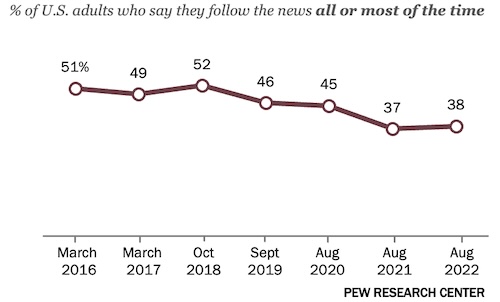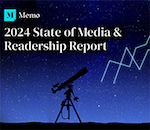Americans are following the news less closely than they used to, according to a recent survey released by the Pew Research Center.
The survey, which polled U.S. adults about their news consumption habits, suggests that day-to-day consumption of the news is going out of favor. Only a little more than a third (38 percent) of American adults said they follow the news—via television, radio, print publications or digital devices—“all or most of the time.” Compare this to a previous Pew survey conducted in 2016, when more than half (51 percent) of U.S. adults reported that they followed the news all or most of the time.
 |
| The share of U.S. adults who say they closely follow the news has decreased in recent years. |
Instead, it appears a growing number of Americans are now becoming what can only be described as casual news consumers. About one in five (19 percent) said they follow the news “only now and then." By contrast, only 12 percent of Americans said the same in 2016. Most news followers in recent years seem to be settling into the role of occasional consumers: A third (33 percent) said they follow the news “some of the time,” a number that's remained virtually unchanged from Pew’s 2016 poll (31 percent).
The number of Americans avoiding the news altogether appears to be growing as well: 9 percent reported that they “hardly ever” follow the news, compared to 5 percent who said the same in 2016.
These findings fit squarely among other recent studies that similarly suggest news consumption rates are declining in the U.S., due either to changing media consumption habits or a growing skepticism among Americans that national media organizations trade in false or biased information. Lending support to the latter theory, only 15 percent of Americans surveyed said they trust the information they get from national news organizations “a lot” (compared to 18 percent in 2016). On the other hand, 26 percent said they have “not too much” trust in the news (compared to 18 percent in 2016) and 13 percent they don’t trust the news “at all” (compared to 6 percent in 2016).
A recent Gallup survey found that 39 percent of Americans said they have no confidence in the news media’s reporting at all.
Pew’s findings also suggest that Americans’ attention to the news in recent years has declined across all age groups, though it appears that younger Americans are becoming especially news averse. Only 19 percent of Americans between the ages of 18 and 29 follow the news "all or most of the time" (down from 27 percent in 2016). Among Americans aged 30-49, that number stands at 27 percent (compared to 46 percent in 2016).
Older adults are more likely to say they still follow the news avidly, but media consumption has dipped among that demographic as well, with 64 percent of those aged 65 years and older claiming they follow the news all or most of the time (compared to 75 percent in 2016). Among those ages 50-64, less than half (46 percent) of Americans claimed they follow the news all or most of the time, compared to 61 percent in 2016.
The Pew survey also reinforces findings from myriad other recent studies suggesting that Americans’ recent decrease in news consumption is particularly pronounced among conservatives. Only 37 percent of those who identify as Republicans or Republican-leaning said they follow the news “all or most of the time” (down from 57 percent in 2016). News consumption habits among Democrat and Democrat-leading Americans, on the other hand, haven’t changed much at all, shifting to 42 percent day-to-day news watchers from 49 percent in 2016.
The Pew Research Center study surveyed more than 12,100 U.S. adults in July and August 2022. Respondents were drawn from the Pew’s American Trends Panel, a nationally representative list of randomly selected U.S. adults.


 Trump Media & Technology Group today reported a $58.2M net loss on $4.1M in 2023 revenues, a disclosure that drove its stock price down 22.6 percent to $47.96.
Trump Media & Technology Group today reported a $58.2M net loss on $4.1M in 2023 revenues, a disclosure that drove its stock price down 22.6 percent to $47.96. Barry Pollack, an attorney at Wall Street’s Harris St. Laurent & Wechsler, has registered Julian Assange as a client with the Justice Dept. “out of an abundance of caution.”
Barry Pollack, an attorney at Wall Street’s Harris St. Laurent & Wechsler, has registered Julian Assange as a client with the Justice Dept. “out of an abundance of caution.” Paramount Global to slash 800 jobs in what chief executive Bob Bakish calls part of an effort to “return the company to earnings growth"... Rolling Stone editor-in-chief Noah Shachtman is exiting at the end of the month due to disagreements with chief executive Gus Wenner over the direction the magazine is taking... The New York Times broke the $1 billion barrier in annual revenue from digital subscriptions in 2023... Press Forward is investing more than $500 million to strengthen local newsrooms.
Paramount Global to slash 800 jobs in what chief executive Bob Bakish calls part of an effort to “return the company to earnings growth"... Rolling Stone editor-in-chief Noah Shachtman is exiting at the end of the month due to disagreements with chief executive Gus Wenner over the direction the magazine is taking... The New York Times broke the $1 billion barrier in annual revenue from digital subscriptions in 2023... Press Forward is investing more than $500 million to strengthen local newsrooms. The majority of news articles are read within the first three days of publication, according to a recent report.
The majority of news articles are read within the first three days of publication, according to a recent report. The Los Angeles Times gives pink slips to 115 people or 20 percent of its newsroom staff... TIME is also laying off about 30 employees, which is approximately 15 percent of its editorial staff... The Baltimore Banner, which was launched by Stewart Bainum in 2022 after he failed to buy the Baltimore Sun, added 500 subscribers per day in the three days following Sinclair Broadcast Group's deal to purchase the Sun.
The Los Angeles Times gives pink slips to 115 people or 20 percent of its newsroom staff... TIME is also laying off about 30 employees, which is approximately 15 percent of its editorial staff... The Baltimore Banner, which was launched by Stewart Bainum in 2022 after he failed to buy the Baltimore Sun, added 500 subscribers per day in the three days following Sinclair Broadcast Group's deal to purchase the Sun.


 Have a comment? Send it to
Have a comment? Send it to 
No comments have been submitted for this story yet.